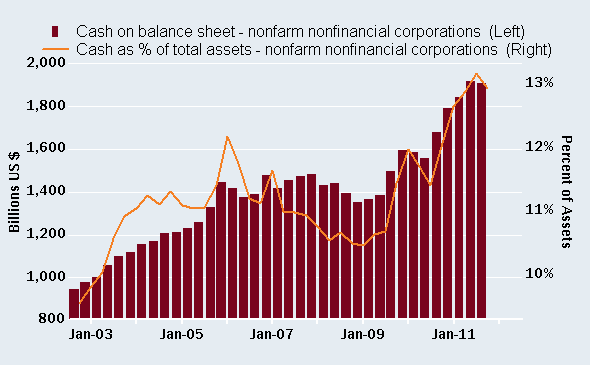If you have a child in your family, you’re probably familiar with the work of Laura Numeroff. She authored the books If You Give a Mouse a Cookie, If You Give a Moose a Muffin, and If You Give a Pig a Pancake. The premiss in this series is simple, one thing leads to another in a fashion that brings us right back to the beginning.
I couldn’t help but think how the same thing applies in the economy. There’s a cycle of companies hiring, people feeling secure in their jobs, spending on new homes, bigger homes, and other goods which drives up demand in all sectors and keeps those companies profitable. Of course, you might say there’s a bit of chicken and egg going on, the companies aren’t hiring because demand isn’t there.
We are now looking at companies having a cash hoard of over $2 Trillion. There are times that interest rates are too high and the cost of money keeps investment down. That’s when the Fed (The Federal Reserve Bank, the Central Bank of the US) typically lowers rates in order to encourage businesses to expand. We are at a very strange juncture in this economic cycle. Mortgage rates are at an all time low but housing is still stagnant. The current 3.75% 30 year fixed rate means that a $1000 per month mortgage payment can cover a mortgage of just under $216,000. That $1000 is below the amount a median income family can budget to the mortgage, while the $216,000 is well above the median home price in much of the country. Why is no one buying? Uncertainty. People are not secure in their jobs, and are afraid to spend. Businesses are waiting to see the results of the election and understand the costs they’ll have over the next year for health care, taxes, etc.
Former Federal Reserve Chairman Alan Greenspan was interviewed last month by CNBC’s Larry Kudlow regarding this issue with the economy and he offered, “The best way I would describe it is to think in terms of two separate economies,†he said. “One is probably 90, 92 percent of the GDP and is doing actually reasonably well. The other 8 percent is largely structures or more exactly, long-lived assets. The attitude of business and households against committing to long-lived assets is extraordinarily suppressed.” This is a great observation, much of the behavior of both the consumer and corporations seems to be similar in this regard, little in the way of long term spending. It’s as though capital itself is on strike.
This brings me right back to today’s title, the fact that Quantitative easing won’t help. That’s not where the problem is. I have banks willing to lend me money short term at 2.5% (my HELOC) and even 1% for just a year (a credit card’s cash advance deal) but I’m not likely to take advantage of either. You’ll note, I don’t have answers, just observations. Something needs to give the economy a needed jump start (imagine Uncle Sam using a defibrillator on the economy) to get out of the strange cycle we are in.

